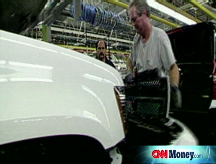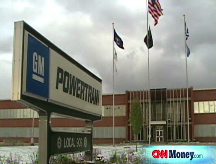Detroit rebound? Wait 'til after next year
Congress wants the Big Three to produce a plan for profitability before it will approve a bailout. This could be within reach...but not until 2010.
NEW YORK (CNNMoney.com) -- A profitable U.S. auto industry just around the corner? Given the crisis hitting the industry, it sounds about as realistic as flying cars.
Congressional leaders are demanding to see details by this Tuesday about how U.S. automakers will start making money again before they'll agree to even have a vote on the $25 billion federal loan package the industry is seeking.
Many critics of the bailout suggest that automakers have shown no indication of how they'll return to profitability. Some argue the Big Three U.S. automakers are doomed to fail even if they get loans from the government.
But General Motors, Ford Motor and Chrysler have already made sizable cuts in production and staffing throughout the year with additional cuts coming in the next few months.
While it's tough to offer guarantees of profitability with so much uncertainty about the economy, if the automakers get the federal help they are asking for, the Big Three could be back in the black as soon as 2010.
With that in mind, here's what GM, Ford and Chrysler are likely to point out next week in their business plan to Congress.
GM (GM, Fortune 500), Ford (F, Fortune 500) and Chrysler have been downsizing for years and have all continued to make even deeper cuts this year which will save them billions of dollars.
GM plans to cut more than 7,000 salaried and contract employees this year as it aims to trim nonunion labor costs by 30%, or about $2 billion annually.
Those departures did not begin until this quarter and most of the remaining employees should leave by the end of the year. So some of the savings won't take effect until next year. And the cost of the severance and retirement packages is causing steeper losses in this year.
Ford and Chrysler are planning similar size cuts in their non-union staff. Chrysler plans to identify by Wednesday 5,000 salaried and contract staff who will leave the company, about 25% of that remaining workforce.
Even hourly workers, despite their union protection, are being affected. So far this year 14,000 hourly staff have left GM, while Ford has trimmed about 7,000 and Chrysler about 8,000 in the last year. Much of those cuts have come through buyouts, but union members are also finding they have weaker job protection than they did before the 2007 labor contract.
"There is a cost to downsizing," said David Cole, chairman of the Center for Automotive Research, a Michigan think tank that supports the bailout. "But the payback is pretty rapid, as long as you can make it to that point."
And more cuts are coming. GM is set to close three plants in December. That will eliminate more than 6,000 additional jobs. Chrysler is set to close its Newark, Del., plant in December, which employs about 1,000 people.
This is the area where the automakers may see some of the biggest savings, assuming they can make it to 2010.
GM is expected to save about $3 billion a year by having the cost of retiree health care shifted to union-controlled trust funds. Ford is likely to save about $2 billion. Estimates at closely-held Chrysler are tougher to come by, but some think it could translate to $1 billion a year or more in savings for the company.
The companies will have to fund those trust funds to meet an estimated $100 billion in unfunded obligations that they face between them. But the United Auto Workers union has agreed to let the companies delay making payments into the fund during the current cash crisis.
The UAW also agreed in the 2007 contract to a two-tier wage structure for all new hires. As part of that deal, which has already kicked in, new hires receive none of the expensive benefits, such as retiree health care coverage, which have been a competitive drain on the automakers.
This should allow the Big Three's plants to have a similar cost structure to those operated in the United States by the Asian automakers once the last of the current autoworkers retire.
All three companies are closing plants and other manufacturing facilities as they try to bring their capacity in line with reduced demand .
This is a process that started years ago but has accelerated this year. GM has announced it is eliminating 12 production shifts, which will bring their North American capacity to only about 3.7 million vehicles.
Beyond the reduced operating costs from plant closings, the most important advantage for automakers might be cutting into the glut of cars and light trucks that are piling up in the face of weak demand. That excess capacity forces the automakers to offer cash back, financing and other incentives to try to move the unsold cars.
Edmunds.com estimates that incentive costs for the U.S. automakers this year is roughly $2,000 a vehicle more than in 2002, a period when the U.S. economy was just coming out of recession and unemployment was still rising. If the automakers could just get back to those levels, it would save them about $12 billion as a group, even if sales remain at current depressed levels.
In addition to cutting capacity, the Detroit automakers are also converting existing SUV plants so they can produce smaller cars, which are now in greater demand.
Still, even with the tens of billions of dollars in planned savings, it's tough to see the U.S. automakers pulling out of this crisis if sales remain at their current levels, the worst in at least 25 years.
Industrywide, U.S. auto sales toppled to a seasonally-adjusted annual sales rate of 10.5 million in October. Full-year sales are likely to come in at just over 13 million and are forecast to be about 12 million in 2009.
"No one, not even Toyota (TM) is cash-flow positive if sales are 10 million vehicles a year," said Shelly Lombard, the automotive credit analyst for Gimme Credit.
She said that even before the recent cuts, GM and Ford were on target to be able to make money in a 15 million-annual-sales market. With the additional cuts prompted by this crisis, they are probably close to making money in a 14 million-sales environment, she said.
Fortunately for them, a 14 million-sales level is very achievable. Sales stayed above 16 million every year since 1999 before this year and haven't sunk below 14.7 million since 1993.
Sales should rebound to about 14 million in 2010, according to forecasts, and climb back over 15 million the following year. Industry officials and experts concede that it is difficult to make predictions that far out in the current economic environment.
But if sales don't rebound, it's not hard to figure out what will happen to the Big Three - even with a federal bailout and all the planned cost savings.
"If the sales number is still 12 million a year or two from now, they're dead," said Lombard. ![]()



